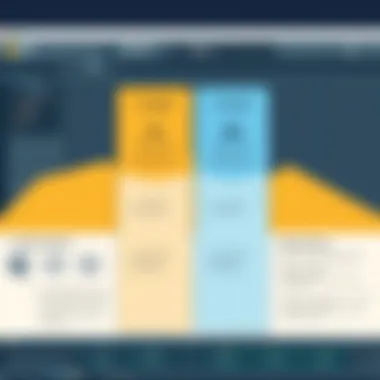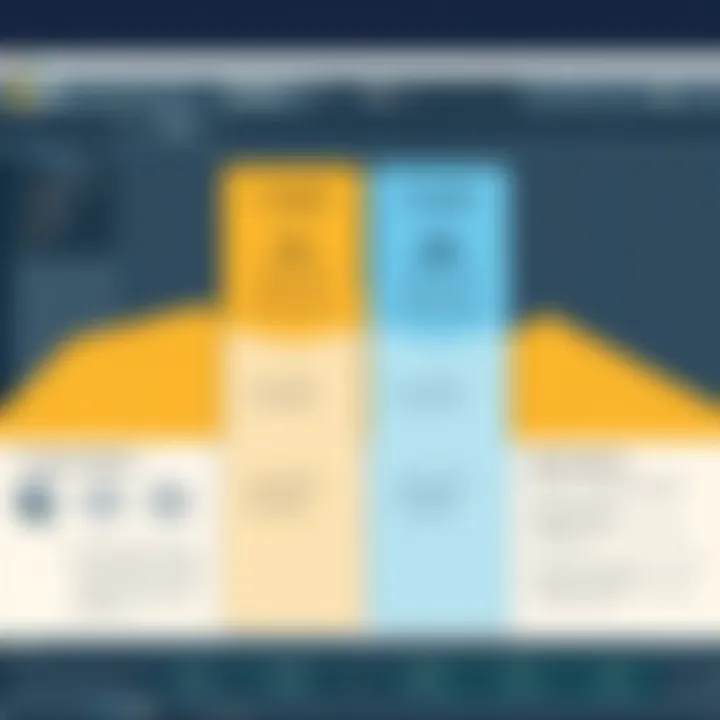Exploring FL Studio Pricing: Editions and Value Insights


Intro
In the realm of digital audio workstations (DAWs), FL Studio has carved out a substantial niche for itself. Understanding its pricing structure is not just a matter of dollars and cents; it’s about grasping the full scope of what this software offers. With different editions tailored to varied user experiences, the need to analyze each offering is paramount.
Software Category Overview
Purpose and Importance
FL Studio serves as more than mere software; it is a playground for both amateur and professional music producers. The purpose behind its varied pricing models lies in accessibility and functionality. The idea is to cater to a diverse audience, each with distinct needs and budgets, whether they’re just dabbling in music creation or diving deep into professional audio production.
Take, for example, a budding musician who seeks to experiment with beat-making and sound design. Alternatively, consider an established producer aiming to work on commercial projects. Both find value in FL Studio, yet their needs and willingness to invest vary significantly.
Current Trends in the Software Category
The software landscape is witnessing a significant shift towards affordability and user-friendliness. DAWs like FL Studio have been at the forefront, reflecting current trends like cloud-based features, subscription models, and extensive online resources. Users increasingly desire a product that not only meets their technical needs but also fits seamlessly into their modern, tech-savvy lifestyles.
Moreover, with platforms like Reddit and user forums buzzing with discussions on features, users are more informed than ever. They often seek recommendations or comparisons, highlighting the growing importance of community insight in making purchasing decisions. As such, understanding the nuances of pricing becomes crucial for maximizing value.
Data-Driven Analysis
Metrics and Criteria for Evaluation
To analyze FL Studio's pricing structure effectively, we need a clear set of metrics. These might include:
- Edition features: What does each version offer? From basic functionalities to advanced plug-ins, the potential user needs clarity about what they will receive for their investment.
- User demographics: Knowing who buys what can provide insights into market trends and needs.
- Cost comparison: How does FL Studio stack up against competitors like Ableton Live or Logic Pro X?
By employing these criteria, potential buyers can evaluate not only the software itself but also how it aligns with their own creative ambitions.
Comparative Data on Leading Software Solutions
A quick glance at the competitive landscape shows the unique position FL Studio occupies.
- Ableton Live: Known for its live performance capabilities, it offers a subscription pricing model which might appeal to those engaged in live shows.
- Logic Pro X: Exclusive to Mac users, it integrates deeply with the Apple ecosystem, often favored by professionals in high-end studios.
However, FL Studio remains a versatile option, combining functionality, ease of use, and a one-time payment purchase, allowing it to resonate with users looking for straightforward ownership.
The decision on which DAW to invest in transcends mere price; it hinges on understanding features, user experience, and the intended use cases. With FL Studio, users are not just buying software; they’re investing in a comprehensive tool supporting their creative journey.
The Essentials of FL Studio
Understanding FL Studio begins with an appreciation of its place in the world of digital audio workstations (DAWs). This isn’t just software; it’s a powerful tool that molds creativity into musical expressions. Whether you're a budding artist or an audio professional, knowing the essentials of FL Studio plays a crucial role in grasping its pricing structure and overall value.
At its core, FL Studio operates on the principle of delivering a comprehensive music production experience. It's not just a repetitive loop of samples; it offers a wide array of features that cater to various music genres and styles. The depth and breadth of tools available can make even the most seasoned users raise an eyebrow in surprise. This flexibility is often cited as a primary reason why users choose it over other DAWs.
When exploring the pricing structure, several key elements come into play. The importance of different editions cannot be overstated. Each edition is tailored for specific user needs, from novice producers to experienced sound engineers. This segmentation in pricing allows users to assess their needs before making a purchase, aligning features with budget considerations.
What is FL Studio?
FL Studio, originally known as Fruity Loops, is a digital audio workstation developed by Belgian company Image-Line. Since its inception in the late 1990s, it has transformed from a simple MIDI sequencer to a full-fledged music production powerhouse. With its intuitive interface and endless possibilities, it draws users both young and old. The software includes tools for audio recording, editing, mixing, and mastering.
What sets FL Studio apart is its non-linear workflow. Unlike more traditional DAWs that often have a linear approach, FL Studio allows users to arrange their tunes in a more flexible manner. This means inspiration can flow freely without the constraints of a rigid structure. The pattern-based system aids in quick experimentation, letting music makers dive into their creative processes without hesitation.
Key Features Overview
When discussing FL Studio, one must acknowledge its myriad features that cater to distinct aspects of music production. Some of the standout offerings include:
- Multiple Editions: Different editions come with varying levels of features—ranging from basic tools to extensive plugin support.
- Wide Plugin Support: Users can enhance their sound libraries with third-party plugins, giving them endless sound possibilities.
- Automation and Control: The ability to automate parameters provides heightened control over sounds and effects, allowing for intricate mix details.
- Intuitive Piano Roll: This feature helps users compose melodies and harmonies effectively, making it easy to visualize notes in a friendly format.
- MIDI Support: FL Studio has robust MIDI support, connecting seamlessly with hardware and MIDI controllers.


In summary, the essentials of FL Studio encapsulate its unique approach to music production, its flexible user interface, and the diverse range of features available at varying price points. This foundational understanding sets the stage for a deeper dive into the pricing structure, helping potential buyers align their individual needs with the most suitable edition.
Pricing Overview
Understanding the pricing structure of FL Studio is crucial for anyone serious about music production. The pricing not only reflects the features included but also guides users to find the best fit for their needs. As we dive into this segment, consider how the variations in pricing correspond with the different capabilities of each edition. Cost isn't simply a number; it serves as a reflection of value, potential use, and overall user experience.
Understanding FL Studio Editions
Fruity Edition
The Fruity Edition is often seen as the starting point for many budding producers. One of its main characteristics is the simplicity and focus it offers. Whereas it lacks advanced features like audio recording, it adopts a user-friendly approach. This makes it especially beneficial for those just dipping their toes into digital audio workstations. A unique feature of the Fruity Edition is the pattern-based workflow, which allows users to compose easily and quickly. However, this very aspect might also be seen as a limitation for those looking to produce more intricate tracks.
Producer Edition
Next up, we have the Producer Edition. This edition addresses many of the limitations found in the Fruity Edition. A significant characteristic of this version is the inclusion of audio recording capabilities, making it a comprehensive solution for more serious musicians and producers. Its unique feature, the Mixer, provides detailed control over effects and sound processing. This edition offers remarkable flexibility, but its increased price may be a deterrent for beginners still exploring their passion.
Signature Bundle
As we climb the ladder, the Signature Bundle takes things a notch higher. This package includes everything from the Producer Edition but adds a treasure trove of additional plugins, which can enhance one's creative potential significantly. It's particularly appealing because it caters to those who desire both quality and variety. One standout aspect is the inclusion of specialized sound packs and instrument plugins that set up a well-rounded palette for production. However, the broad array of tools might overwhelm newcomers, making it essential to primarily focus on what matters most.
All Plugins Bundle
Last but not least is the All Plugins Bundle. This edition is the crème de la crème for those who want the full FL Studio experience. It provides everything offered in the Signature Bundle, plus all future plugins released. Thus, it's an investment in a continuously evolving toolkit. The primary appeal is its comprehensiveness, affording producers a wealth of options as they progress. Nonetheless, the price tag reflects this breadth, possibly making it an intimidating commitment for new users.
Price Comparison of Editions
When determining which version of FL Studio to purchase, comparing prices is essential. Each edition has distinct features, and understanding these disparities allows users to select the most cost-effective option while ensuring it meets their creative requirements.
Here’s a quick rundown of what you can expect:
- Fruity Edition: Generally the most affordable option; great for beginners but limited in functionality.
- Producer Edition: Higher price, but offers more capabilities, including audio recording.
- Signature Bundle: Mid-range, includes extra plugins that enhance usability and creativity.
- All Plugins Bundle: Premium pricing represents a full-scale arsenal of tools, best suited for dedicated professionals.
By comprehensively analyzing these aspects, potential buyers are better equipped to navigate the intricacies of FL Studio's pricing landscape, ensuring that they can make decisions that align with both their skills and budgets.
Assessment of Costs
Understanding the Assessment of Costs is vital when navigating the landscape of FL Studio software. This section provides insight into what buyers should consider on their journey towards a suitable purchase. With the varied editions and pricing strategies available, users might be left scratching their heads over which option is the best fit for their unique requirements. Therefore, breaking down the costs into digestible units helps in aligning one’s financial capacity with their musical aspirations.
The evaluation of costs goes beyond merely checking price tags. It encompasses a careful calculation of features and what each tier offers, allowing users to weigh the benefits against financial outlay. Opting for the lesser version may save dollars upfront, but could also limit functional possibilities, ultimately leading to further costs down the line.
Direct Purchase Costs
When it comes to Direct Purchase Costs, one must grasp how each FL Studio edition translates into real money. The price points of the software can change based on different regions however, they maintain a generally stable tier structure. Understanding this element can be a game-changer for many.
Here’s a breakdown of the common editions:
- Fruity Edition: Tailored for beginners, this cost-effective option covers the basics of music production but lacks advanced features like audio recording.
- Producer Edition: A step up, ideal for those serious about composing and recording their own sounds. This edition unlocks additional tools for a deeper exploration of music creation.
- Signature Bundle: Besides the perks of the Producer Edition, users gain access to various plugins that enhance sound design—worth considering for those ready to elevate their production quality.
- All Plugins Bundle: This top-tier choice can be seen as a jackpot for professionals. It includes every feature and plugin at a higher price point, aimed at users who need the complete suite.
These prices can fluctuate during times of significant promotions or sales events like Black Friday. Users who keep an eye out for these changes might find an opportunity to snag their desired edition for less.
Periodic Discounts and Promotions
Periodic Discounts and Promotions represent an often underappreciated aspect of the software pricing world. Many manufacturers, including Image-Line, frequently offer sales, making the right timing an essential factor for prospective buyers.
In many cases, users report that waiting for a seasonal discount yields substantial savings, sometimes reaching up to 30% off. Additionally, students can often access further price reductions, a major advantage for those just starting their musical journeys but strapped for cash. It's also worth noting that Image-Line has a history of running flash sales tied to holidays or anniversaries.
Moreover, subscribing to newsletters and following online communities can keep you informed about upcoming promotions. Here are some avenues for potential discounts:


- Official FL Studio Website: They often feature special sales events, particularly during industry exhibitions.
- Social Media Announcements: Platforms like Twitter and Facebook can offer real-time updates during limited-time promotions.
- YouTube Tutorials and Reviews: Sometimes, influencers and educators might have discount codes tied to their content.
Value Proposition
Understanding the value proposition of FL Studio is crucial when considering its pricing model. This aspect outlines how the features offered align with the costs associated with each edition. The beauty of FL Studio lies not only in its intuitive interface but also in how it caters to diverse user needs—from amateur creators to seasoned professionals. By examining the features relative to cost, potential buyers can determine which edition best suits their musical aspirations and budget.
Features Relative to Cost
When purchasing FL Studio, it’s essential to assess what you're getting for your investment. Each edition comes with a set of features that escalates in complexity and capability, reflecting in its price. The Fruity Edition, for instance, serves as a solid launchpad for beginners, allowing them to explore basic functionalities for music production without breaking the bank.
The Producer Edition takes it a notch higher by offering advanced features like audio recording and full MIDI support, making it ideal for those who wish to delve deeper into their music production journey. Owners of this edition often find that the relatively modest price increase compensates for the added capabilities, enabling richer, more polished tracks.
On the contrasting end, the All Plugins Bundle provides an extensive toolkit with unlimited capabilities for sound design and manipulation. While it comes at a premium price, the value lies in the breadth of creative freedom it offers, thereby appealing to professionals and serious hobbyists alike.
The Signature Bundle sits comfortably between the two, presenting a host of plugins without the overwhelming array found in the All Plugins Bundle. This makes it more approachable, yet not heavy on the pocket. By aligning features with their cost, FL Studio maintains a balanced portfolio that caters to multiple segments of the user population, amplifying its desirability.
Target Audience Considerations
Deciphering the value also involves understanding your target audience. Here’s a closer look at three key groups that often find themselves exploring FL Studio.
Beginners
Beginners are often stepping into the world of music production, and FL Studio provides a welcoming gate. Its user-friendly interface and a wide range of tutorials can help new users grasp the essentials quickly. This software's bold simplicity often becomes a standout characteristic for novices. They find the Fruity Edition particularly appealing, as it allows them to experiment without an upfront heavy financial commitment.
The built-in help tools and community support are unique to this level of engagement, making it easier for beginners to overcome initial challenges. This hands-on learning experience is pivotal for skill development, nudging them toward eventual upgrades as their expertise grows.
Professionals
For professionals, the choice often hinges on efficiency and feature depth. High-caliber producers and musicians value the advanced options provided in the Producer and Signature Editions. These editions excel in offering complex audio and MIDI capabilities, crucial for building sophisticated audio productions.
One unique feature is the ability to record multiple takes seamlessly, allowing for greater creativity during the production process. Although the up-front costs are higher, many professionals deem the investment worthwhile, thanks to the software's ability to streamline workflows and enhance productivity.
Educational Institutions
Educational institutions find FL Studio a beneficial tool for teaching music production skills. Its versatility allows schools to introduce students to the world of music composition and sound design effectively. The availability of bulk pricing for institutions makes it accessible, while the comprehensive learning materials foster an engaging learning environment.
Institutions appreciate the ease of use and the ability to scale lessons from basic to advanced levels. The continuous updates and support from Image-Line keep the curriculum fresh and relevant, making FL Studio a staple in modern music education.
In summary, the perceived value of FL Studio software varies widely across different user groups. By understanding these nuances, potential buyers can make more informed decisions regarding which edition aligns with their own creative endeavors and financial capabilities.
Customer Experiences
In the realm of software purchase decisions, understanding customer experiences stands out as a crucial element. With many audio production software options out there, the value of feedback from current users of FL Studio cannot be overstated. These experiences provide a window into the day-to-day usability and performance of the software, helping prospective buyers set realistic expectations and make informed choices.
When diving into customer experiences, several specific factors come into play. For one, user reviews can reveal the longevity and reliability of the software. FL Studio users often mention its flexibility and powerful features, which has earned it a loyal following over the years. Benefits of understanding customer experiences also include gaining insight into the learning curve associated with FL Studio, as different users have varied backgrounds and skill levels. Some explore its functionality as beginners in music production, while others, seasoned producers, may utilize more advanced features.
At the same time, comparing customer feedback across different editions of FL Studio can shed light on whether a particular version meets specific requirements. For example, a casual music enthusiast might find the Fruity Edition perfectly adequate, while a professional music producer may seek the advanced capabilities found in the Signature Bundle. Such experiences are indicators that can help users align their needs with the right edition.
"A product’s worth is often defined by the experiences it generates for its users. With FL Studio, countless stories of creativity and collaboration define its reputation."
Reviews and Feedback
Reviews and feedback from FL Studio users play a significant role in shaping perceptions about the software. Many platforms exist for users to share their thoughts, but prominent venues like Reddit or specialized audio production forums often yield deep and thoughtful opinions.
Positive feedback frequently centers around:
- The user-friendly interface that eases the music production process.
- The vast array of plugins and sound libraries available for creativity.
- Regular updates that enhance existing features and provide new instruments or effects.


On the flip side, naysayers sometimes point out potential drawbacks. Some reviewers discuss issues with performance on less powerful computers or the steep learning curve for total beginners needing to grasp the multitude of available features. Moreover, long-time users occasionally express dissatisfaction with pricing changes, especially when considering updates versus new versions. Overall, a balanced view emerges, with constructive criticism serving to improve the software further.
Community and Support
The community surrounding FL Studio significantly contributes to the overall customer experience. A strong and engaged user base is present in various online spaces, from forums to social media platforms. Active members are often quick to provide solutions, tips, and inspiration that can help users maximize their experience with FL Studio.
Support from the official FL Studio website is also quite robust. Users can find:
- Comprehensive documentation detailing software functionalities.
- Video tutorials that guide beginners through complex features.
- Community forums where users can pose questions or air grievances, and often receive immediate assistance from fellow customers or staff.
Being part of a vibrant community adds a social dimension to using FL Studio. Many users share project files, collaborate on compositions, and even offer critique on each other's works. Such interactive experiences add depth that goes beyond mere software usage, fostering a sense of belonging within the music production world.
Alternative Software Solutions
Exploring alternative software solutions in the context of FL Studio gives insight into the broader digital audio workstation (DAW) market. Understanding what else is available helps users not just see FL Studio in isolation, but in the context of similar tools. This lays down a comprehensive framework that can shape a user’s purchasing decision.
When one digs into alternative software solutions, it’s not simply about switching from one product to another; it involves assessing features, user experience, and, of course, pricing. This comparison empowers users with the knowledge to make informed choices based on their unique music production needs.
Comparison with Competing DAWs
Ableton Live
Ableton Live stands out in the realm of DAWs due to its live performance capabilities. Many musicians favor it for its flexibility during live gigs, allowing for real-time manipulation of sounds and effects. It's not just a studio tool, but a bridge for artists who want to take their work from the studio to the stage without breaking a sweat.
One key characteristic of Ableton Live is its Session View, which allows users to mix and match loops and samples on the fly. This is particularly beneficial for electronic music producers, who appreciate the intuitive layout for triggering clips. However, its unique focus on this live performance aspect might overlook traditional linear production workflows that some users may prefer.
Logic Pro
Logic Pro is often seen as a heavyweight in the DAW ring, revered for its robustness and advanced tools for music composition. It offers a well-rounded feature set that suits everything from recording to editing and mixing. Logic Pro is especially popular among macOS users due to its seamless integration with Apple products.
The standout feature here is its MIDI capabilities, allowing for intricate manipulation of instrumental tracks. Users assessing DAWs for intricate music production may find Logic Pro’s advanced features invaluable. However, a downside is its exclusive availability on Mac platforms, which can alienate some potential users who operate on different systems.
GarageBand
GarageBand, often regarded as the gateway DAW for beginners, is designed for ease of use. Its user-friendly interface makes it an ideal choice for those new to music production. In many ways, it mirrors elements of its bigger sibling, Logic Pro, but in a more accessible format.
A notable characteristic of GarageBand is its variety of pre-recorded loops which can breathe life into tracks without requiring deep technical knowledge. It's perfect for casual users or hobbyists who wish to dabble in music creation without feeling overwhelmed by complex features. However, its simplicity may also be a downside for advanced users who require more professional tools for intricate projects.
Pricing Trends in the DAW Market
The DAW market has seen some notable pricing trends recently. With competition heating up, more software solutions are popping up at varying price points, catering to a wider range of users. Offers like subscription models are becoming increasingly common, followed by traditional one-time purchase options.
These shifts are reflective of changing consumer preferences and the rise in freelancer and remote working cultures, where music production is often a side hustle or full-time gig. Users today are looking for affordability and flexibility, thus pushing brands to adapt their pricing models accordingly.
The freemium model, where basic features are free and premium features require a payment, is garnering attention. It allows potential users to dip their toes before committing, which is a smart strategy in the competitive DAW landscape, keeping brands like FL Studio on their toes.
By considering alternatives, users not only broaden their choices but also better understand where FL Studio stands in relation to its contemporaries, solidifying their intent on their final decision.
Closure
In this discussion, we’ve unraveled the intricate pricing structure of FL Studio, shedding light on its various editions, meaningful features, and the value they present to different user demographics. Understanding these elements is essential for anyone considering investing in this comprehensive software.
Final Thoughts on FL Studio Pricing
When it comes to FL Studio pricing, the array of options can feel overwhelming at first glance. However, this flexibility is what makes it appealing to a diverse range of customers from rookie producers to seasoned sound engineers. Each edition serves its purpose, catering to the specific needs and budgets of its users. It’s crucial to align your choice with your production style and long-term goals.
For instance, the Fruity Edition is well-suited for beginners focused on beat-making, while the Signature Bundle offers expansive tools for professionals looking to push their creative boundaries. The appreciation for what each edition brings can significantly affect your satisfaction with the software.
Guidance for Potential Buyers
Here’s a condensed guide to help you traverse the FL Studio pricing landscape effectively:
- Assess Your Needs: Before making a decision, evaluate the specific features you truly require. Are you focused mainly on creating music or do you need advanced mixing capabilities?
- Compare Editions: Don’t just look at prices; consider what each edition includes. For example, the All Plugins Bundle is great for those who desire every tool available without additional purchases.
- Look for Deals: FL Studio regularly offers discounts during certain times of the year. Keep an eye out for these to save a few bucks.
- Explore Online Resources: Forums like Reddit can provide first-hand testimonials and can be a great place to gauge user sentiment about the various editions.
- Consider Future Needs: If you’re not sure what edition suits you now, consider how your needs might change down the line. Opting for a more robust edition early on might save you the hassle of upgrading later.







